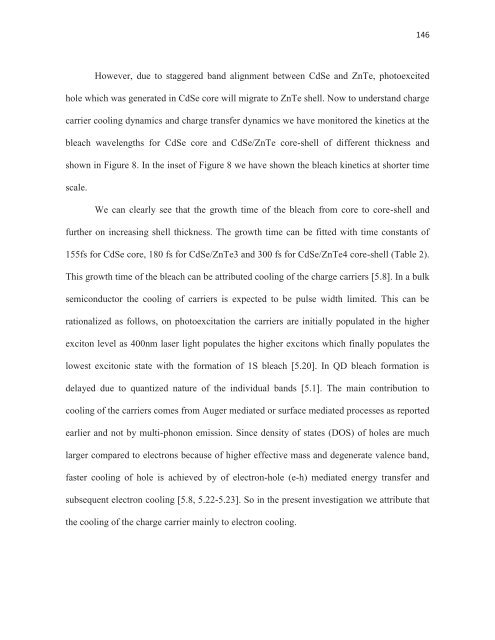CHEM01200604009 Sreejith Kaniyankandy - Homi Bhabha ...
CHEM01200604009 Sreejith Kaniyankandy - Homi Bhabha ...
CHEM01200604009 Sreejith Kaniyankandy - Homi Bhabha ...
Create successful ePaper yourself
Turn your PDF publications into a flip-book with our unique Google optimized e-Paper software.
146<br />
However, due to staggered band alignment between CdSe and ZnTe, photoexcited<br />
hole which was generated in CdSe core will migrate to ZnTe shell. Now to understand charge<br />
carrier cooling dynamics and charge transfer dynamics we have monitored the kinetics at the<br />
bleach wavelengths for CdSe core and CdSe/ZnTe core-shell of different thickness and<br />
shown in Figure 8. In the inset of Figure 8 we have shown the bleach kinetics at shorter time<br />
scale.<br />
We can clearly see that the growth time of the bleach from core to core-shell and<br />
further on increasing shell thickness. The growth time can be fitted with time constants of<br />
155fs for CdSe core, 180 fs for CdSe/ZnTe3 and 300 fs for CdSe/ZnTe4 core-shell (Table 2).<br />
This growth time of the bleach can be attributed cooling of the charge carriers [5.8]. In a bulk<br />
semiconductor the cooling of carriers is expected to be pulse width limited. This can be<br />
rationalized as follows, on photoexcitation the carriers are initially populated in the higher<br />
exciton level as 400nm laser light populates the higher excitons which finally populates the<br />
lowest excitonic state with the formation of 1S bleach [5.20]. In QD bleach formation is<br />
delayed due to quantized nature of the individual bands [5.1]. The main contribution to<br />
cooling of the carriers comes from Auger mediated or surface mediated processes as reported<br />
earlier and not by multi-phonon emission. Since density of states (DOS) of holes are much<br />
larger compared to electrons because of higher effective mass and degenerate valence band,<br />
faster cooling of hole is achieved by of electron-hole (e-h) mediated energy transfer and<br />
subsequent electron cooling [5.8, 5.22-5.23]. So in the present investigation we attribute that<br />
the cooling of the charge carrier mainly to electron cooling.
















